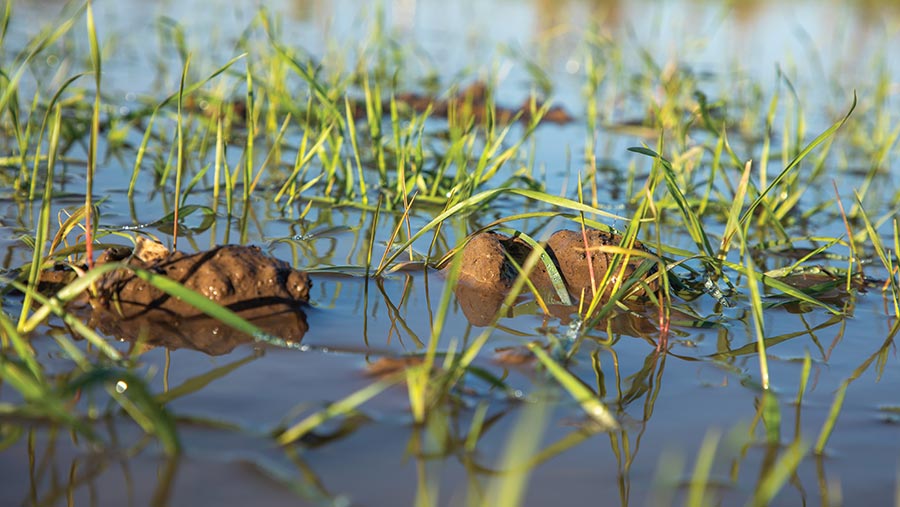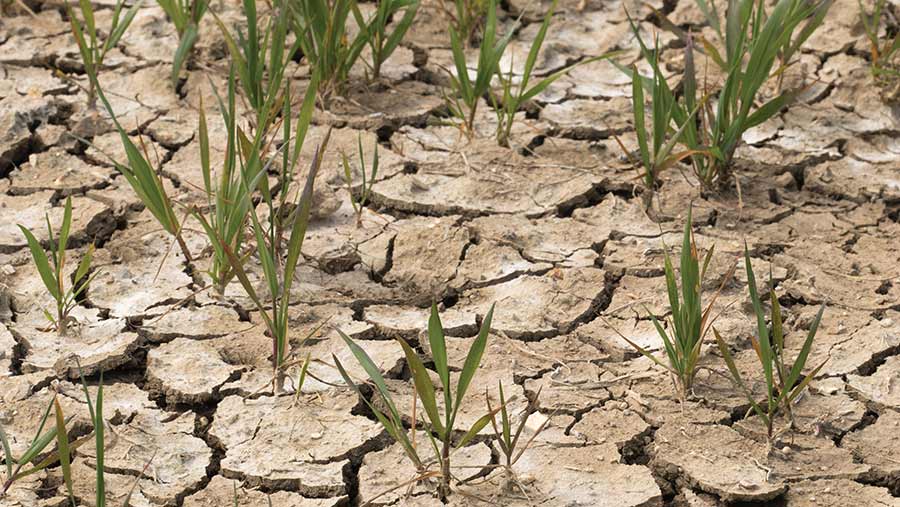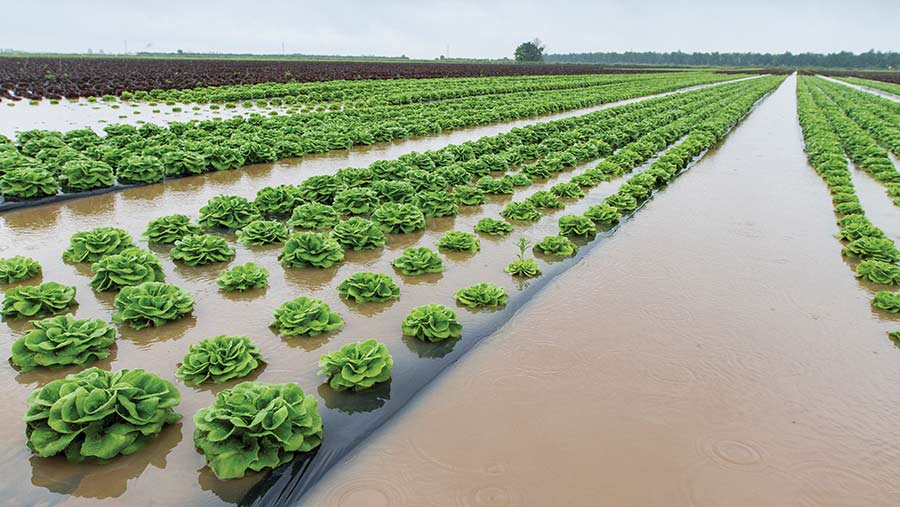How to build climate resilience into farm business plans
 © GNP
© GNP Urgent action is required to build greater climate resilience into farming systems to ensure that productivity isn’t compromised, and farms remain viable, experts stress.
According to the UK Climate Change Committee, climate change poses a direct risk to crops, livestock and trees, through increased exposure to heat stress, drought risk, waterlogging, flooding and fire, as well as pests, diseases and invasive, non-native species.
See also: 5 new-year farm tax and finance tips
While that verdict was given back in June 2021, following a report entitled Independent Assessment of UK Climate Risk, there have been subsequent updates with the same tone.
More recently, the committee has warned that the rate of adaptation progress is too slow.
Extreme weather events are already challenging the way that farms are run, highlights ADAS.
The four named storms – Agnes, Babet, Ciaran and Debi – that hit the UK in autumn 2023 brought exceptionally wet and stormy weather, with flooding and wind damage affecting all four nations.
What’s at risk from changing climatic conditions?
- Species and habitats – risk from pests, pathogens and invasive species
- Soils – risk of seasonal aridity and wetness
- Natural carbon stores – risk to carbon sequestration and risk of greenhouse gas emissions
- Productivity – risk of fall in agricultural output
- Aquifers and land – risk of sea level rise and salt water intrusion
- Landscape character – risk from extreme weather events
Rainfall in autumn 2023
The wet 2023 autumn saw parts of the country receive more than 150% of its long-term average rainfall, although overall, the UK recorded a seasonal rainfall total of 409.8mm – 122% of the 1991-2020 average.
According to the Met Office, the mild and wet autumn is consistent with the ongoing pattern emerging as our climate continues to change.
Current situation
There’s no denying that agriculture sits at the cutting edge of climate change, says Dr Andrew Cottrell, senior applied climate scientist at the Met Office, who has been looking at what farmers can expect in the coming years, and what that will mean for their businesses.
“The headline findings are that there will be hotter summers and warmer winters,” he reveals, with temperatures typically being 1C warmer than they are now.
That has implications for livestock and crop heat stress, as well as factors such as growing season length, post-harvest storage regimes, and changing pests and diseases.
The other main findings were wetter winters and drier summers, along with an increase in rainfall intensity.
“A 10% increase in winter rainfall can be expected in the next 30 years,” reports Andrew, who adds that this will bring problems associated with flooding and waterlogging, as well as limited access to land.
“The future increase in rainfall intensity is a threat to soil erosion, nutrient leaching, crop lodging and soil run-off, as well as to productivity.
“Of course, risks are not the whole story with climate change,” he continues.
“There will be opportunities, too – from longer grazing periods and extended production seasons, to earlier maturity and new crops.”
Andrew stresses that what really matters to farm businesses is the weather in a particular year.
“You will always get variability. But we are predicting an increased likelihood of extremes – what are now quite rare events will become more common.”
On-farm actions
Charles Ffoulkes, director for climate adaptation and resilience at Adas, has been assessing the adaptation actions that farms can take.
Working with the Met Office, Adas has been examining the resilience measures that cover the climate hazards of heat, drought and wildfires, flooding and wet conditions, and changing seasonality.
For each of these, a range of adaptation measures were identified before being rated for their impact on reducing the climate risk, ease of implementation and upfront cost.
From there, they were able to identify the “quick wins” – things that farmers can put in place to alleviate the worst of the conditions, and help them to farm in the most appropriate way, without having to make huge investments.

© Tim Scrivener
Quick wins to adapt to flooding and wet conditions
All farms
- Improve water run-off, containment and drainage
- Develop a flood contingency plan
- Review power supply
Livestock
- Consider vaccination against new and prevalent diseases
- Develop a control plan with your vet to avoid key issues, such as lameness
- Plan grazing to ensure spare fields are available in wet periods
- Improve feed bin cleanliness and design to reduce deterioration
- Install free-draining material around housing
Crops
- Increase use of compost, green manures and mulches
- Increase soil organic matter
Quick wins to adapt to heat stress and drought
All farms
- Improve on-farm water management
- Ensure tractor cabs are air-conditioned
- Put fire breaks between fields, hedges and woodland
Livestock
- Increase diversity of forage mix
- Use deeper rooting forage species
- Transport animals at night
Crops
- Establish crops early
- Choose slow-developing varieties
- If needed, irrigate at night
- Use irrigation to aid harvesting on dry ground
- Avoid harvesting in the hottest parts of the day
In Scotland, Farming for a Better Climate has issued advice on reducing the impact of heavy rainfall events following the very wet winter weather.
It has highlighted six main areas for farmers to concentrate on. However, with no one-size-fits-all approach, it stresses that these are a range of actions that might improve resilience at the farm level.
- Protect soil surface – keep the soil surface covered by residues or by sowing a cover crop, to reduce erosion, aid infiltration and prevent nutrient loss.
- Limit soil compaction – compacted soils impede drainage and keep water locked up in the upper profile, increasing flooding risk and reducing the soil’s ability to hold water. Correcting compaction also helps with yield performance.
- Reduce run-off – use buffer strips around watercourses to slow the flow of water and trap sediment particles. Strategically placed traps and bunds will also reduce run-off and soil loss.
- Maintain field drains – drains can silt up and block, preventing water from getting away. Drain outfalls should have a reasonable clearance between the outfall and normal water level. Cleaning, clearing and repairing outfalls may be required.
- Clear ditches – check that the water can flow, and clear sections of the ditch on a regular basis.
- New drains – given the likelihood of more intense winter rain, consider adding new field drains. A full drainage plan can be drawn up, with a view of completing it in sections.
The organisation has also issued advice to farmers about feeding flood-damaged forage stocks, with an emphasis on avoiding any bacterial contamination.
Any forage that has been flooded by slurry or sewage waste has a high risk of contamination. Listeria, clostridia, bacilli and enterobacteria are all threats responsible for poor intakes and growth rates, abortions and deaths.
Farmers are advised to consider forage texture where there’s been soil and silt contamination, as well as any changes in smell and pH – both of which can indicate secondary fermentation and bacterial growth.
What other actions are recommended?
The UK Climate Change Committee continues to assess the risks to agriculture, and has produced four reports in the past year.
Senior analyst Brendan Freeman admits that multiple risks have been identified when two climate scenarios were tested, with all being related to average temperatures, shifts in rainfall patterns and seasonality.
“Not surprisingly, the frequency and duration of flooding events is one of those,” he says. “In particular, high-grade land is very vulnerable to flooding, so there’s a productivity concern.”
The impacts will vary regionally, with farms being at the forefront of those, he continues. “In the South, there will be more issues around soil moisture deficits than in the North, for example.”
In addition, weather events that currently occur one in every five years will be taking place every other year by 2050, he says.
“We know that adaptation is already taking place on farms, but it’s poorly recorded,” reports Brendan. “So there’s a lack of data to use to show what’s being done and how well they are working.”
Despite that, he maintains that building a more resilient agricultural sector is possible and relies on the following measures being implemented:
- Greater implementation of water use efficiency measures to limit drought risk – some will be expensive (such as reservoirs), others are easier and cheaper to install (such as rainwater harvesting).
- Keeping soils protected and in good condition to maintain sustainable production, get water to infiltrate and reduce soil erosion and run-off.
- Selecting crops and livestock, and relevant protection measures, to reflect temperature extremes.
- Making use of agroforestry and hedges to provide shade and soil erosion benefits
- Putting flood mitigation and contingency planning in place.
- Improving preparations for pest and pathogen management.
Measuring climate resilience at a national level is done by looking at data on things such as livestock mortality rates and the abundance of pollinator species, as well as the uptake of sustainable farming measures and soil health measurements.
However, two other factors are required to deliver the necessary resilience, he believes. “One is funding and investment, while the other is people with the necessary skills.”

© GNP
Case study: Vegetable production
For Guy Singh-Watson of organic vegetable producer Riverford, the climate problems encountered in the business are about the extremes, not the averages.
At the company’s base in Devon, the greatest difficulties come from intense rainfall in late summer and early autumn, which leads to soil loss or damage, and makes harvesting very difficult.
“We are focusing on reducing soil loss and we have changed what we are doing,” he says. “It’s becoming increasingly obvious that what was acceptable practice 10 or 20 years ago is not right any longer.
“We now accept that we can’t cultivate our steeper south-facing slopes, for example, as the risks are too high.”
Heavy rain events in late summer and early autumn also affect their green manuring practices and make establishing new leys more difficult.
“We now use swales across our fields, cultivate less than we used to, grow more perennial crops, have introduced agroforestry, add organic matter to the soil to improve percolation rates and do shallower cultivations where possible.
“We are also building reservoirs. As an industry, it’s clear that we have underestimated the urgency and gravity of climate change – things are changing faster than we would like.”
He is producing crops that cost about £3,000/acre to get to harvest, and the same amount again to actually harvest them.
“So losing a crop is disastrous. If that starts to happen every three years in 10, as some are predicting, I will be out of business.”
Temperature changes have increased risk at the start and end of the vegetable growing season, leading to shortages and gluts, he says.
“You would think that longer, milder autumns would be good for the industry, but it means the predictability of harvest is changing.”
The same applies to grazing livestock, adds Guy, as keeping them out in a longer-than-expected season without poaching swards becomes more challenging.
As the extremes become more frequent, small changes are more disruptive, especially as you get closer to the equator, he notes.
“In winter, we bring vegetables up from Spain and Italy, parts of which have been affected by a prolonged drought. As a result, brassica production is moving away from the south of Spain and going further north.
“Likewise, olive oil producers have only had one-third of their usual crop this year. What we are seeing in this country is mild in comparison.”
Case study: beef and arable
Northamptonshire mixed farmer Mark Jelley has already made changes to his farming practices and machinery capacity because of the unpredictable weather and changing climate.
After oilseed rape failed for three years in a row – thanks to very dry conditions in September – he has now abandoned the crop.
“Planting it in August and then having a very dry spell afterwards into September meant it just couldn’t get established,” he says.
He has also had to be far more vigilant at harvest to limit crop damage and loss of quality from diseases such as ergot.
Machinery policy also reflects that he now covers the field work in a shorter period of time.
“Crop quality is less predictable now. So we are growing more cereals for livestock feed, rather than human consumption, to remove some of that risk.”
Field work windows are shorter than they used to be, especially in the autumn, he adds.
“We have to make the most of the opportunities that we get, so our machinery capacity reflects that.”
An earlier calving period for his beef cattle is the result of more early spring grass growth and milder winters, which also helps to avoid the risk of drought later in the year.
“Now that we can produce more grass in the spring than we need at the time, we have moved to deferred grazing. Leaving some of that grass as a standing hay crop allows us to graze it later in the year, when there can be a shortage.”
Grazing grass margins on arable land is another technique that he has adopted to ensure there’s enough grass for the season.
“Last year, we were able to graze a long way into the summer, but that’s not always possible if it doesn’t rain.
”A robust vaccination programme is used when the cattle are housed, due to increased pressure from pneumonia caused by warmer, more humid conditions.
“It’s prevention rather than cure, and it helps to keep our antibiotics use right down.”
More exotic disease risks, such as bluetongue, are also on his watchlist as the climate changes.
“There’s no doubt that we will be managing extremes on a more regular basis and certain things are getting harder to do, but we are adapting.”
Business planning is becoming more important, he adds, but a lack of data specific to the farm’s location and enterprise type, as well as time pressures, makes that difficult to do.
Will Environmental Land Management help?
Climate adaptation is being built into Environmental Land Management (ELM), says Charles Ffoulkes of Adas, so that there is government support for farmers to take action.
The three different levels – Sustainable Farming Incentive (SFI), Countryside Stewardship (CS) and Landscape Recovery – will all have options that help farms remain resilient in a changing climate, he outlines.
Existing SFI actions such as integrated pest management measures and soil health actions are good examples, he notes, while both CS and Landscape Recovery offer more scope, and bring in measures such as tree planting and natural flood management.
“Behind this is the National Adaptation Programme, which commits Defra to producing a plan every five years, showing how it plans to adapt to the impacts of climate change,” says Charles.
“The latest plan runs from 2023 until 2028 and covers five core areas – the natural environment is one of them. That’s why there’s a link with ELM.”
How heavy rainfall has affected our transition farmers
Relentless autumn rain has waterlogged crops, damaged herbicide applications and caused issues with slugs.
Areas most affected include parts of eastern Scotland, north-east and eastern England, southern England and the east of Northern Ireland.
For Vaughan Hodgson, who farms in Kirkbride, Wigton, Cumbria, heavy rainfall is not an unusual event, as the farm averages 1,250mm.
This year, the 244ha arable and broiler business has escaped the worst of the autumn storms, and Vaughan has managed to drill 95% of the planned winter cereal area.
“About 75% of that looks reasonable,” he reports. “So there is potential for some of it.”
The farm sits on heavy red clay, silty sand and black peat. The combination of some flooding and patchy headlands through the winter means that there will be bare areas in the spring, Vaughan accepts, which he will need to plan for.
The early autumn for Andy Bason, farm manager at Newhouse Farm, Northington Down, Alresford, Hampshire, was unusually wet.
Parts of the region received almost 200% of the October monthly rainfall. November was better rainfall-wise, but still above average.
Speaking immediately before Christmas, Andy described conditions on the 800ha, mainly arable unit as “very soggy”.
He reported that his forward planning was having to be very fluid, especially on the heaviest land. Winter beans largely remained unplanted, although an area was drilled in the frost in November.
“We’re waiting to see how they fare,” he says. With seed remaining in the shed, he is reluctant to order more.
“After all the terrible weather we’ve had, getting hold of spring seed isn’t easy anyway.”
As there’s nothing he can do about the situation, he is waiting to see how long the wet weather continues.
His agroforestry enterprise has been badly affected by deer pressure, rather than the weather, giving him a different challenge.
“We’ve lost a lot of trees, but it can’t be blamed on climate change.”
